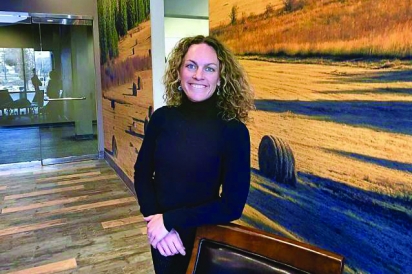Advancing Ag
On the day Edible Aspen caught up with Kate Greenberg for this story, she was in her office for the first time in a month. For good reason: As the state’s agriculture commissioner, Greenberg spends a lot of time in the field, visiting farmers and ranchers and advocating for local agriculture across the state.
Appointed by Governor Polis in 2018, Greenberg is the youngest person and the first woman to hold that position, and her background is as robust as her workload: She’s been a farmer, worked for watershed conservation organization the Sonoran Institute, and organized farmers through the National Young Farmers Coalition.
Day to day, she moves legislation, makes policy decisions, advises the governor, and oversees the Department of Agriculture, which comprises around 300 staff and over 75 program areas. Hermagency does everything from taring the scales (making sure they’re fairly set) for farmers’ markets to advancing the Colorado Proud logo so that consumers know to buy local.
But Greenberg describes her job simply as “advancing Colorado agriculture, protecting farmers and consumers, and supporting stewardship of the natural world.”
We checked in to hear how she’s helping Colorado navigate the future of agriculture.
Q: What are the most pressing issues for young and beginning farmers in Colorado today?
The issues we’ve seen for a long time are still front and center: land access and affordability, and access to credit and financing. How do you get a foot in the door? There’s still some major barriers to entry. Issues of climate are becoming so much of the lived experience, really for every farmer and rancher, but beginning farmers and ranchers are really stepping into it now.
Q: How does your department address those issues?
We’re standing up a new $30 million revolving loan fund intended to target beginning farmers and ranchers, and have the authority to enter into the lending landscape by partnering with financial institutions to distribute those loans. Success for that program is to remove barriers to financing for underserved farmers and ranchers. For a lot of beginning farmers without access to land or from a farm family, you first need experience to build a case for why you should be eligible for a loan. So, we also support paid internships through the Agricultural Workforce Development Program. On climate, we passed a bill creating the Agricultural Drought and Climate Resilience Office. There’s also the Soil Health Initiative, looking at tools in the production and food supply chain where farmers and ranchers have autonomy and agency to make decisions that help mitigate climate change and build resilience. We’ve fought hard for a renewable energy program, allowing us to help cover the costs for farmers and ranchers to site renewable projects on their operations.
Q: How is agriculture adapting with climate change, and how is your department responding?
Adaptation is being led locally: Folks are thinking about different crops, or how to grow while putting water back into the system. But for farmers and ranchers, it’s incredibly difficult to be innovative when you’re underwater, or when you have no water, or when you’re figuring out if you have to cull your herd, and if [your career] is over. As an agency, it wasn’t until this year that we finally had a seat at the climate table with the Ag Drought and Climate Resilience Office. We’re building new program areas, shifting focuses and priorities, and trying to resource communities. Trying to support and remove barriers in partnership with producers so they can adapt in the way that makes sense for them.
Q: Can you speak to the state of water?
We can’t grow without water, right? Nothing we do at the Department of Agriculture would be meaningful if we don’t have secure water for agriculture. So I’m trying to build our capacity to be at the water table. The water quantity issue is paramount: There’s a shortage on the Colorado River; we’re three years out from mandatory curtailment in the Republican River Basin and just a few years more out from the same in the Rio Grande. Agriculture is the first place that cuts are going to go. My hope is that as a state, and as a country, we continue on the track of collaborative decision-making. There are creative solutions.
Q: How can the public help ensure a sustainable future for agriculture?
A lot of agriculture feels very alienated from the public, and misunderstood. So it’s critical for consumers to take the time and effort to engage directly with agriculture, whether through education, buying local food, asking farmers questions, or doing farm visits. Once people start meeting each other and learning more, they see how inherently connected we are. It’s headwater protection for our drinking water. It’s the capacity of our working lands for climate mitigation and carbon sequestration. And preserving that potential is one of the most fundamental needs right now for resilience. Understand we rely on each other, no matter where we live.






